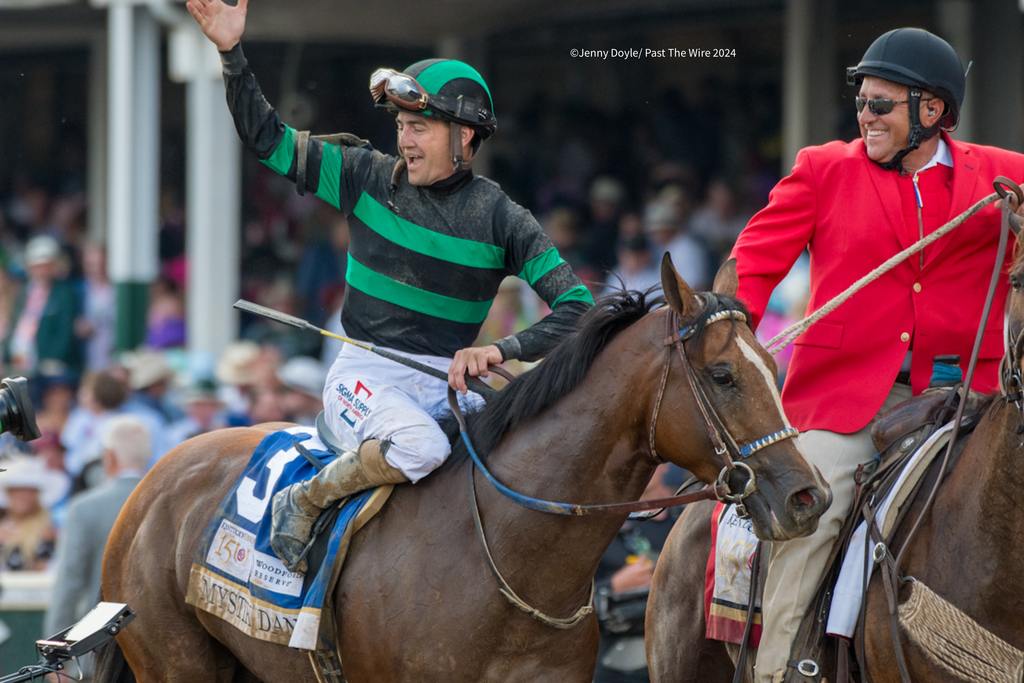
With Mystik Dan clinching a victory at the Kentucky Derby, all eyes are now on the upcoming Preakness Stakes at Baltimore’s renowned Pimlico Race Course. Amid whispers of a potential Triple Crown victory, skepticism surrounds Mystik Dan due to his narrow win and the daunting challenge from his Arkansas Derby conqueror.
Adding to the intrigue, the Preakness, and potentially altered Belmont Stakes due to Saratoga’s unusual circumstances, fans and experts alike ponder Mystik Dan’s chances. Despite hurdles, such as a shorter rest period and controversial race adjustments, the quest for the coveted Triple Crown sparks heated debate and anticipation.
This article explores the burgeoning narrative around Mystik Dan’s challenging path ahead, dissecting elements that both hinder and herald his potential to seize racing’s most esteemed accolade.
Who’s the Favorite?
Despite the tradition of the Kentucky Derby winner being the pre-Preakness favorite, this year’s spotlight isn’t on Mystik Dan but rather on Muth, a Bob Baffert-trained thoroughbred sidelined from the Derby. Muth, who impressively claimed the Arkansas Derby, outpacing Just Steel and leaving Mystik Dan behind in third, brings an aura of intrigue to the Preakness Stakes.
With a $2 million investment by Amr Zedan, Muth’s record—four wins and two second-place finishes in six starts—underscores his consistent performance and rising trajectory. His second-place finish to Fierceness at the Breeders’ Cup Juvenile highlighted his prowess as a formidable contender early in his career. Baffert’s praises of Muth’s quality and improving form set the stage for what many anticipate to be a compelling showdown.
Given his track record and potential, the odds for betting on Preakness Stakes are expected to favor Muth, with odds placing him between 4-5 and 9-5, underscoring his status as the one to watch at Pimlico.
Why Can Baffert Compete in the Preakness but Not the Derby?
Bob Baffert, one of the most recognizable figures in horse racing, finds himself in a unique position entering the Preakness Stakes. Despite enduring a well-publicized suspension by Churchill Downs Inc. stemming from Medina Spirit’s positive medication test after the 2021 Kentucky Derby, Baffert remains unrestricted by any state or national regulatory body concerning participating in races outside those owned by Churchill Downs.
This ban, now extending into its third year—beyond the originally stated two—centers around allegations of insufficient contrition and responsibility acceptance on Baffert’s part, claims he contests by highlighting his clean record post-incident and asserting that he has fulfilled his penalty.
Baffert’s ability to compete in the Preakness but not the Derby is particularly poignant, considering his past. After Medina Spirit’s controversy, Baffert faced heightened scrutiny yet successfully passed all imposed tests during the 2021 Preakness, showcasing his compliance with rigorous standards. His 90-day suspension in 2022, recognized across jurisdictions, has since concluded, allowing him to return to racing worldwide—save for Churchill Downs-owned venues.
This dynamic underscores the ongoing debate within the racing community about fairness, rehabilitation, and the future of one of its most storied participants. Baffert’s situation exemplifies the complex intersection of sportsmanship, regulation, and redemption in the high-stakes world of thoroughbred racing.
Wasn’t Pimlico Meant To Be Demolished?
Despite longstanding speculation and whispers of demolition, Pimlico Race Course remains a steadfast, albeit charmingly dilapidated, icon of horse racing history. Critics have often described Pimlico as a relic—an unrepaired testament to the past with a track surface that, surprisingly, maintains good condition amid its surrounding decay.
This narrative took a significant turn when ownership of Pimlico was transferred from The Stronach Group—a powerhouse in the racing industry owning venues like Santa Anita—to the state of Maryland. This move ushered in a new era for Pimlico, particularly with The Stronach Group retaining intellectual rights to the Preakness Stakes until 2026.
Recently, an ambitious plan was set into motion to revitalize this historic site. Governor Wes Moore’s signing of a bill to allocate $400 million in state bonds for the reconstruction of Pimlico signals a promising future. Although major demolition and reconstruction were scheduled to begin this year, delays have pushed the timeline back, with the 150th Preakness Stakes poised to be the venue’s swan song in its current form. Consequently, the Preakness will temporarily relocate to Laurel Park, sparking a blend of optimism and realism among stakeholders—some anticipate a quick one-year turnaround, while others forecast a more prolonged two-year project. This pivotal moment represents not just the rebirth of a venerated site but a significant milestone in preserving and enhancing horse racing’s cultural heritage.
How Often Does a Horse Win Both the Derby and Preakness?
The achievement of winning both the Kentucky Derby and Preakness Stakes is a rare and remarkable feat in horse racing, occurring approximately 40% of the time since 1932. Notably, it hasn’t been accomplished since 2018, when Justify, trained by Bob Baffert, clinched the Triple Crown. This tradition of dual victories dates back to when Burgoo King triumphed in both races in 1932, marking the first horse to achieve this since the Preakness and Derby began being run consistently in the order we recognize today.
The significance of winning both races highlights a horse’s speed, stamina, and heart, with 13 horses etching their names into history by securing all three Triple Crown jewels. The path to this prestigious achievement often runs through California, with a notable number of contenders, like Silver Charm, Real Quiet, and California Chrome, having their roots in the Golden State’s vibrant racing scene. This statistic underscores the rigorous preparation and exceptional talent required to dominate the first two legs of the Triple Crown, setting the stage for the ultimate test at the Belmont Stakes.
Who’s the Underdog To Cheer For?
In the world of thoroughbred racing, the underdog story that captures hearts this season comes from the barn of legendary trainer Wayne Lukas. At 88 years old, Lukas brings an unmatched blend of experience and tenacity to the track, making any horse under his care a contender to watch.
This year, two such hopefuls are Just Steel and Seize the Grey. Despite Just Steel’s 17th-place finish in the Kentucky Derby and Seize the Grey’s victory in the Pat Day Mile on the same day, both horses promise intriguing narratives as they head to the Preakness Stakes with double-digit odds. Lukas, who has clinched victories in America’s most prestigious races, continues to defy age, supervising workouts from horseback with the support of a cane.
Lukas’s presence at Pimlico, often found on a folding chair waiting for passersby to engage in conversation, embodies the spirit of horse racing. As the morning line takes shape post-Monday’s draw, enthusiasts and bettors alike eye Lukas’ chargers for potential upset victories, embodying the underdog spirit that makes thoroughbred racing unpredictably thrilling.
That said, underdog wins are far more unlikely in the Preakness than in the Kentucky Derby. A smaller field means less traffic, helping speed horses find their room to break through. The biggest longshot to ever win the Preakness was Master Derby in 1975 who won with odds at 23-1. Contrast that to the Kentucky Derby which has had five horses with odds of 50-1 or longer win the race.




